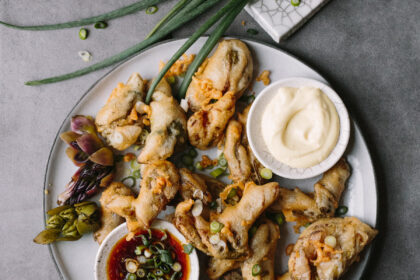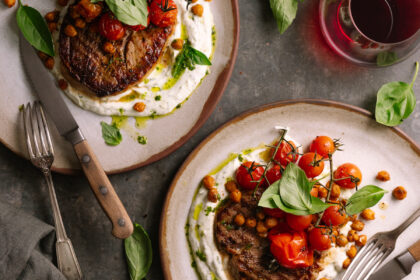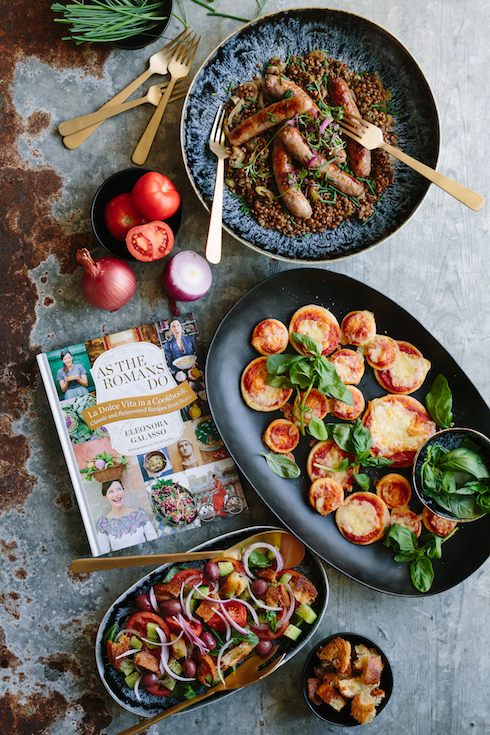
Rain or shine, summer or winter – Italian cooking wins my vote every single time. There’s just something generously simple about the food culture of Italy: not too many ingredients, comforting and robust, fragrant and delicious.
I recently had a look through Eleonora Galasso’s new book As The Romans Do: La Dolce Vita in a Cookbook – Classic and Reinvented Recipes from Rome, available from Poetry Stores. The book is positively vibrant, filled with familiar Italian favourites like saltimbocca, panzanella, semifreddo, various pastas and porchetta. She puts a playful twist on many of the recipes, accompanied with excellent photographs of the dishes as well as her beautiful surrounds in Rome. She’s an international Instagram sensation, so her pictures are stunning.
Here are three of Eleonora’s recipes – easy and accessible enough to make all year round. In the photographs you’ll see some of Poetry’s new black and gold tableware that made these vibrant dishes look even more delicious. Everything is available online and in store from Poetry – look out for the noir and petra ranges.
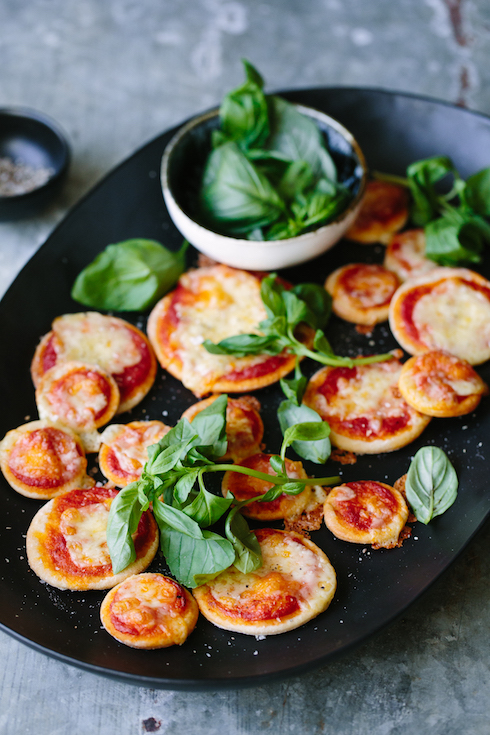
Mini pizzas with tomato sauce (pizzette rosse): makes about 40 pizette
Recipe from As The Romans Do by Eeleonora Galasso.
- 250 g passata (sieved tomatoes)
- small handful of basil leaves, chopped
- 2 tablespoons extra virgin olive oil
- 1 teaspoon salt
- 100 mozzarella, cut into cubes
For the dough:
- 500 g strong flour, plus extra for dusting
- 1 teaspoon caster sugar
- 250 ml lukewarm water
- 30 g unsalted butter, softened
- 1 teaspoon extra virgin olive oil
- 1 teaspoon salt
To prepare the dough, sift the flour into a large mixing bowl with the sugar. Dissolve the yeast into 250 ml lukewarm water, add it to the flour and sugar and mix together for 5 minutes. Add the butter, oil and salt and mix for a further 2-3 minutes to form a soft, sticky dough. Add up to 50 ml more water as needed, the goth should feel neither sticky not dry. Cover the bowl with a clean tea towel and leave to rise in a warm place for 1 hour, or until almost doubled in size.
Preheat oven to 200 C. Mix the passata, basil, oil and salt together in a bowl and set aside.
To make the pizzette, roll out the risen dough on a clean, floured surface, to a 1 cm thickness. Press down on the surface of the dough with a small cup of glass of your choice to form your pizzette circles. Spoon a little of the passata over the centre of each pizetta, being sure to leave the edges empty so that you have that typical white/red contrast of a good margherita.
Cook in the oven for 15-20 minutes, adding a few mozzarella cubes to the top of each pizzetta halfway through cooking, until the cheese is bubbling and the pizzetta bases are crisp. Enjoy.
My notes: I prefer the pizzette a little thinner, so I roll out the dough to a thickness of 5 mm.
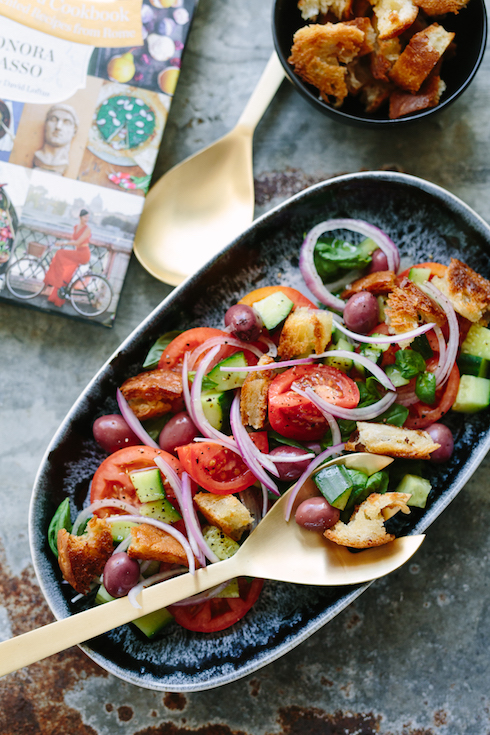
Bread salad (panzanella): serves 4
Recipe from As The Romans Do by Eeleonora Galasso.
- 4 tablespoons extra virgin olive oil
- 200 g rustic bread loaf, torn into bite sized pieces
- 4 firm tomatoes
- 2 large red onions, peeled
- 1 celery stick, trimmed and cut into 2 cm cubes
- 15 pitted black olives, finely chopped
- 40 g rocket leaves, finely chopped
- small handful of basil leaves, finely chopped
- 20 ml white or red wine vinegar
- 100 g pecorino romano cheese, cut into 2 cm cubes
- salt & pepper
Heat 2 tablespoons of olive oil in a large non-stick frying pan over high heat. Add the bread pieces and fry, turning occasionally, for 5 minutes until crisp and golden all over. Remove from the heat and set aside.
Place the tomatoes in a bowl and pour over boiling water to cover. Leave for 1-2 minutes, then drain, cut a cross at the stem end of each tomato and peel off the skins. Cut the tomatoes roughly into 5 mm cubes, discarding the seeds.
Slice the onions and place them in a bowl of cold water for 10 minutes. Drain and dry on a clean tea towel. In a salad bowl, mix together the sliced onions, chopped cucumber, celery, tomatoes and olives, then add the chopped rocket an basil leaves, pour over the vinegar and the remaining 2 tablespoons of oil and season with salt & pepper. Finish the panzanella by adding the toasted bread pieces and giving everything a final gentle mix to ensure the bread is covered in all the juices. This salad is delicious served immediately, or you can keep it in the refrigerator for up to 3 days, letting it absorb the mix of aromatic flavours. Scatter over the pecorino before serving.
My notes: Peeling and deseeding the tomatoes are not always necessary – I love serving them unpeeled and with seeds. I also love serving the herbs and olives whole and not chopped.
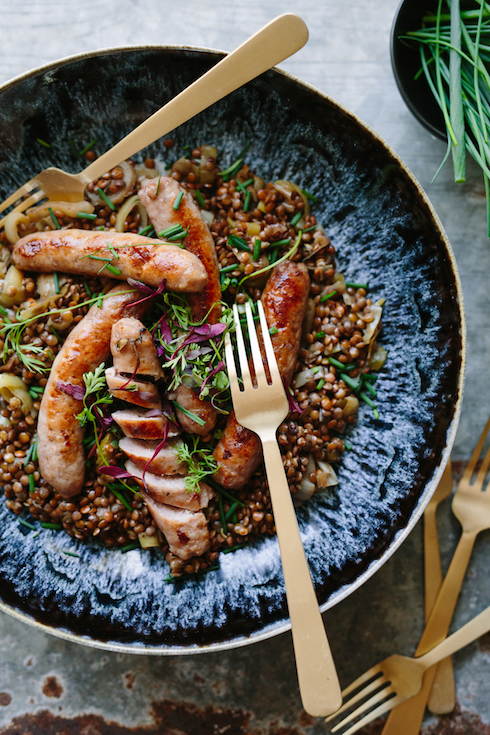
Braised sausages with lentils, leeks & fennel: serves 4
Recipe from As The Romans Do by Eeleonora Galasso.
- 4 tablespoons extra virgin olive oil
- 1 leek, trimmed, leanend and finely sliced lengthways
- 1 fennel bulb, trimmed and cut into rough strips
- 400 pork sausages
- 250 Castelluccio or Puy lentils
- 350 ml vegetable stock
- 10 g fennel seeds
- small handful of chives, chopped
- salt & pepper
Warm the oil in a frying pan over medium heat, add the leek and fry for 5 minutes until softened and translucent. Add the fennel and sausages and cook for 5 minutes until the sausages are browned on all sides.
Add the lentils to the pan and pour over the stock. Bring to a boil, then reduce the heat to a gentle simmer and leave to cook for 25 minutes, or until the lentils have softened and the sausages are cooking through. Divide the lentils and sausages between plates and scatter over the fennel seeds and chopped chives to finish. Serve.
My notes: I used black lentils.

